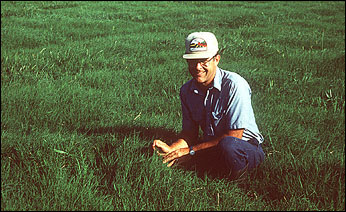
Bermudagrass (Cynodon dactylon), a warm-season grass native to southeast Africa, is widely grown in the southeastern United States and is gaining popularity in southern Missouri. It is a deep-rooted, sod-forming grass that spreads by means of stolons and rhizomes and grows to a height of 15 to 24 inches. Perhaps its greatest advantage is that it is productive during the months of June, July and August when the quantity and quality of cool-season grasses such as tall fescue (Festuca arundinacea) and orchardgrass (Dactylis glomerata) are poor (Figure 1). Another advantage of bermudagrass is that herbage production is distributed more evenly throughout late spring and summer than that of other warm-season grasses.
Bermudagrass produces an extensive root system that provides some drought tolerance. It responds well to nitrogen fertilization and produces a large quantity of dry matter for either grazing or hay production when soil moisture is not limiting. Although both seeded and sprigged varieties of bermudagrass are available, sprigged varieties generally have a yield advantage over seeded varieties. Hybrid bermudagrasses are popular for hay production because they are responsive to nitrogen fertilizer, have a high yield potential and are relatively fast drying. Bermudagrass makes good use of animal manures and, if well fertilized, gives high animal weight gains per acre.
Bermudagrass is adapted to a wide range of soil conditions but is best suited to a well-drained site. Hulled seed of common bermudagrass or other seed-propagated varieties should be planted in spring. Hybrid varieties can be planted in April or May as sprigs. Because hybrid varieties produce little or no viable seed, they must be vegetatively propagated (sprigged). In the southern United States, annual clovers, small grains and annual ryegrass are often overseeded in the fall to provide winter-spring production.
Variety selection
One of the primary considerations in selecting a bermudagrass variety for Missouri is cold tolerance. Many varieties will not survive the cold winters in Missouri. Consideration should also be given to yield potential, quality and palatability. Recently developed varieties show improved winter hardiness, while maintaining higher yield and forage quality. Many of these improved varieties are hybrids with Coastal, which is known for its greater resistance to foliage diseases and drought than common bermudagrass species but is not itself winter hardy. A description of the most common varieties adapted to southern Missouri follows.
- Midland is a F1 hybrid between Coastal and a winter-hardy common. It is a tall, leafy variety similar in appearance and growth to Tifton 44 but is slightly more winter hardy. It is widely used in Oklahoma, particularly the central and western parts. In eastern Oklahoma, Midland is used on lighter, well-drained, soils.
- Hardie is a sterile F1 hybrid that has hay production potential equal to or greater than that of Midland or Tifton 44 but has a history of thinning or loss of stand with age. This characteristic is probably due to its sensitivity to low pH (less than 5) and susceptibility to disease. In trials at the Southwest Research Center in Mt. Vernon, Missouri, stand loss was greater than 50 percent for Hardie while other varieties maintained good stands.
- Guymon is a variety established by seeding. It has good winter hardiness and is well adapted to the upper South. Guymon has a shorter growth habit but denser tillering than Midland, Tifton 44 and other bermudagrasses. In Oklahoma, forage yields of Guymon have been similar to those of Greenfield.
- Wrangler is a new seeded variety developed in Oklahoma. Little comparative performance information is available on Wrangler, but developers indicate that it has good winter hardiness and is expected to be adapted to the same regions as Guymon. It is expected to have forage yield and quality close to that of Guymon.
- Greenfield is widely used in southwest Missouri, northern Arkansas and eastern Oklahoma. It is a "common" type bermudagrass that is established by sprigging. It has good cold tolerance and other adaptation features. It establishes well because of its aggressive growth and forms a relatively dense sod. It maintains good stands on a range of soil types and has overall better performance than hybrid varieties under low-yield environments. It yields less than hybrid varieties like Tifton 44 and Midland in high-yield environments.
- Tifton 44 was selected from several thousand F1 hybrids between Coastal and a winter-hardy common bermudagrass from Berlin, Germany. It is a tall, leafy variety widely similar to Midland in appearance and growth habit. It is slightly less cold tolerant than Midland and Hardie. Tifton 44 has maintained good stands and yielded much better than Hardie at the Southwest Research Center at Mt. Vernon. It is used throughout the southeastern United States.
- Midland 99 was released in spring 1999 by the Oklahoma, Missouri, Kansas and Arkansas agricultural experiment stations and the USDA Agricultural Research Service. It is a fairly cold-tolerant hay-type variety similar in appearance and growth habit to Midland and Tifton 44. Dry matter yields of Midland 99 are higher than those for Tifton 44. Midland 99 and Tifton 44 have similar forage quality.
- Quickstand is a short-growing, winter-hardy variety used for turf, erosion control and pasture. It has aggressive growth and forms a more dense sod than the hay type varieties like Tifton 44 and Midland. Quickstand forage yields in Oklahoma have been similar to those of Greenfield, and less than those of Tifton 44, Midland and Midland 99.
- World Feeder is a proprietary patented variety of Agricultural Enterprises Corp., Oklahoma City. Extensive testing in Oklahoma and other states indicates World Feeder to be moderately winter hardy and well adapted to the northern half of the bermudagrass belt, but not superior in forage yield or forage quality to standard varieties. In Oklahoma, forage yields of World Feeder have been equal to, or less than, those of Greenfield and Quickstand. It has yielded substantially less than Tifton 44, Midland and Midland 99.
Establishment
While bermudagrass is best adapted to deep sandy loam and medium-textured soils, with appropriate management it can be grown on shallow, droughty soils. Although bermudagrass can be extremely drought tolerant, it does not produce much forage under arid conditions. Bermudagrass will not tolerate waterlogged conditions. Like most grasses, it does best at a pH of 5.5 or above and is highly responsive to the application of nitrogen fertilizer; potassium (potash) is also important for forage growth and winter hardiness.
Soil fertility at establishment is essential to obtain a healthy and vigorous stand of bermudagrass. Obtain a soil sample for analysis well before establishment time because lime is slow to affect soil pH and should be applied 6 to 12 months before planting bermudagrass. Dolomitic limestone should be used if the soil test indicates magnesium is needed. Ensure that adequate phosphorous and potassium are applied before planting. Potassium and phosphorous applications are most effective if incorporated into the soil during bed preparation. After planting, nitrogen should be applied at a rate of 30 to 50 pounds per acre when stolons have reached a length of 3 inches. A second application of 30 to 50 pounds N per acre can be applied 30 days later if adequate soil moisture is available. Good fertility at establishment will help reduce the time required for coverage and may allow for limited grazing or hay production during the first growing season.
Typically, bermudagrass is established between April 1 and June 1. Later plantings are successful only if adequate moisture is available. Bermudagrass should be planted into a well-tilled, level and firm seedbed. Seeded varieties can be either broadcast or drilled. The desired seeding depth is 1/4 inch. Seeding rates are 4 to 8 pounds of pure live seed per acre.
Bermudagrass can be sprigged at many different rates. The faster the stand is desired, the more sprigs that must be planted. A rate of 20 (one bushel is 1.25 cubic feet) gives an acceptable rate of ground cover in southwest Missouri. Sprigs, consisting of underground rhizomes and plant crown and stolons, should be planted at a depth of 1 to 2 inches in 20- to 40-inch rows (Figures 2 and 3). Planting any deeper will delay establishment. Rolling after planting will help ensure good soil contact and enhance soil moisture retention during dry weather. For best results, buy sprigs from a reputable dealer. Use only fresh, moist, healthy and weed-free sprigs that have been grown under a good fertility program. Sprigs should be kept moist but not wet, cool, and in the shade to ensure survival. As a rule of thumb, sprigs should be planted within 24 hours of digging.
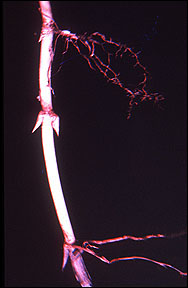
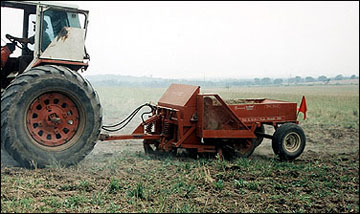
Weed control is important in the successful establishment of bermudagrass. Bermudagrass is very intolerant of shading and weed competition. Land that has been cultivated should be smoothed with a disk harrow just before planting to destroy germinating weed seeds. Both a pre- and post-emergent herbicide treatment is recommended to control broadleaf weeds. Currently, the use Karmex is suggested for pre-emergent weed control. After sprigging, 2, 4-D amine can be used to control broadleaf weeds. Check with your regional MU Extension specialist for suitable herbicides and application rates required to control weed species in bermudagrass. Grazing or mowing during the establishment phase may help control escaped weeds. However, the first grazing should not be taken until runners have lapped between the sprigged rows and the grass is 6-8 inches tall.
Improving established bermudagrass
Revitalizing an old stand of bermudagrass may be more cost-effective than planting a new stand. Before spending money on replanting or alternate forage crops, a producer should first compare the economics of improving an existing stand. Poor soil fertility is the primary reason for a weak bermudagrass stand. The result is reduced carrying capacity and decreased animal performance. When fertilized properly, bermudagrass will often compete with and crowd out most weed species.
Based on the level of weed infestation, the producer must decide whether a simple modification to the current fertilizer regime will bring about the desired change or whether the use of a herbicide is justified. If weeds make up more than 20 percent of the existing vegetation, the application of a herbicide may be required. Used properly, herbicides are safe, economical and effective.
There is currently no evidence that aeration of "sodbound" or "rootbound" pastures by periodic tilling has a positive effect on yield. A three-year study in Oklahoma found that discing or chiseling bermudagrass pastures caused severe yield reductions and no significant increase of forage.
Fertilization for grazing and hay
Bermudagrass requires adequate amounts of fertilizer throughout the grazing season to produce high yields and maintain quality. In southwest Missouri, the grazing season begins in May and continues to the first of September.
Applying nitrogen increases both yield and quality of bermudagrass. In a nitrogen source and rate study at the Southwest Research Center, the yield of bermudagrass increased linearly for nitrogen rates from 0 to 300 pounds per acre. Data from other states, including Oklahoma, Texas and Mississippi, show a positive response to added nitrogen in improved yield and protein.
Splitting the application of fertilizer throughout the growing season improves efficiency, which means that the plants make use of a greater percentage of the nutrients, particularly nitrogen. Application rates should be based on desired yield and weather conditions. Depending on conditions, fertilizer should be first applied in mid-May; earlier application may give an additional cut of hay or extend the grazing season, but may also encourage weeds. For pasture, apply 50 to 100 pounds of nitrogen per acre in mid-May after grass "greens-up." Apply 50 pounds per acre every 30 days thereafter. The application of nitrogen after mid-September delays hardening of the bermudagrass and increases the risk of winter injury.
Bermudagrass is a "luxury consumer" of potassium. It will take up more potassium than is needed for plant growth if excess potassium is available. Therefore it is recommended that phosphorus (P) and potassium (K) needs be made in split applications with nitrogen. Phosphorus and potassium needs should be determined by a soil test. If a soil test is not available, apply fertilizer with an N-P-K ratio of 4-1-3.
In a typical haying situation, 100 pounds of nitrogen per acre in a mixed fertilizer would be applied on or about May 15. Depending on desired yield, soil moisture and temperature, between 35 and 100 pounds of nitrogen per acre would be applied every 30 days through mid-August.
Hay management
Table 1 shows total dry matter yields for four bermudagrass varieties harvested at either 21- or 28- day intervals beginning June 1 in a trial at the Southwest Research Center in Mt Vernon. Plots were cut five times each year on the 21-day interval compared to only four cuttings for the 28-day interval. Despite one less cutting, the 28-day interval produced higher dry matter yields for all varieties.
Table 1. Three-year average yields of four bermudagrass varieties, pounds per acre.
| Variety | Cutting frequency | |
|---|---|---|
| 21-day | 28-day | |
| Guymon | 4,851 | 6,099 |
| Hardie | 5,546 | 6,697 |
| Tifton 44 | 6,696 | 8,640 |
| Midland 99 | 7,287 | 9,442 |
| Source: Southwest Research Center, Mt. Vernon (1996-1998) | ||
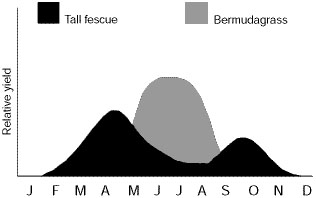
The distribution of forage yield during the growing season can be affected by the harvest interval (Figure 4). Harvesting every 28 days beginning June 1 resulted in a typical single peak yield curve or "hump." Shortening the harvest interval to 21 days tended to flatten out the curve, but reduced total yield.
As with any forage, the stage of growth affects quality. The more mature the forage, the lower the quality. With bermudagrass, the protein level can decrease significantly if cutting is delayed. Research at the Southwest Center showed that bermudagrass can produce high-quality hay (Figures 5, 6 and 7). Crude protein (CP) values generally ranged between 16 percent and 20 percent, NDF (neutral detergent fiber) between 55 percent and 60 percent, and ADF (acid detergent fiber) between 25 percent and 30 percent, and varied little over the different cuttings. Although yields were higher when cut every 28 days, quality measurements were similar if cut every 21 or 28 days. Only small differences were seen in quality among the different varieties.
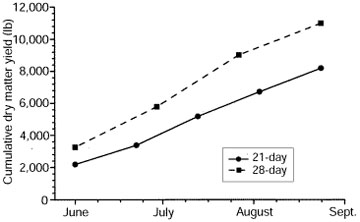
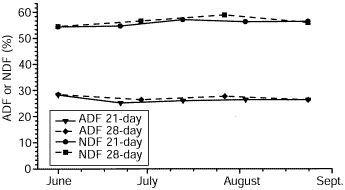
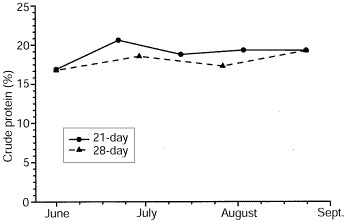
Therefore, to optimize yield and quality, bermudagrass should be cut on a 28- to 30-day schedule, beginning about June 1. To maximize yields, bermudagrass should not be harvested after Sept. 1; clipping or burning in mid-February can remove residual material.
Grazing management
Bermudagrass can be either grazed continuously or used in a management-intensive grazing system. The choice of grazing system depends on the producer's needs and level of management. The primary goal of a grazing system should be to maintain a vigorous growth of high-quality forage. This would be accomplished through adequate fertilization and management of the growth of the grass. A secondary goal should be to maximize forage use. This goal is best accomplished through a management-intensive, or rotational, grazing system. In a rotational grazing system, the amount of time cattle graze an individual pasture before being moved to another one could be as short as a 12 hours to as long as 7 days.
Grazing should begin when the bermudagrass is 6-8 inches tall, and when it is grazed to 3-4 inches, cattle should be moved to another pasture. If bermudagrass reaches 8 inches or more in height, it should be clipped or cut for hay. Clipping the whole pasture after grazing to a uniform height of 3-4 inches is recommended. The growth rate of bermudagrass will vary throughout the growing season because of climatic conditions. Generally, the growth rate will be greater in the May-June period than in the July-August period because of a greater amount of available moisture.
Overseeding bermudagrass pastures
Bermudagrass pastures lend themselves well to overseeding with cool-season annual forages. Annual forages can be drilled (sod-seeded) directly into the bermudagrass sod during mid to late September and provide excellent fall, winter and spring grazing. Forages that can be overseeded into bermudagrass include the cereal grains and annual ryegrass. Cereal grains are planted at 90 to 100 pounds of seed per acre and annual ryegrass at 25 to 30 pounds of seed per acre.
Before establishment of the cool-season grasses, it is critical that the bermudagrass be grazed or mowed short. This will reduce competition for sunlight between the germinating cool-season plants and the bermudagrass. Similarly, during the spring the cool-season forage needs to be grazed or mowed short to prevent any delay in bermudagrass growth. It may be possible to manage the annual ryegrass for reseeding, providing a volunteer stand for several years.
Weed control
Maintaining a vigorous and healthy stand of bermudagrass helps to prevent invasion by weeds. If a broadleaf weed problem does develop, it can usually be checked by the timely application of an herbicide. Consult your regional MU Extension specialist for the correct herbicides and application rates for controlling weed species in bermudagrass. The herbicide label provides important information on the period of time that must elapse between application and resumption of grazing.
Pests and diseases
Pests and diseases are usually not a serious problem with bermudagrass pastures. Invasions of fall armyworm and spittlebug can be a problem and leafspot infections may occur, particularly when soil potassium levels are low. Keeping the potassium levels up, burning the fields just before green up, and harvesting on a regular basis all help to prevent a major disease outbreak. If a disease or pest outbreak does occur, check with your regional MU Extension specialist for the correct pesticides and application rates.
Summary
Of the warm-season perennial grasses available, bermudagrass is one of the most suitable in a management-intensive grazing system. It has the potential to provide a large quantity of high-quality forage throughout the summer in southern Missouri if managed correctly. Within its zone of adaptation, bermudagrass is hardy enough to survive with little care but responds quickly to more intensive management. Since establishment costs are a major expense, producers should do everything possible to ensure success. The most important considerations during establishment of bermudagrass are to prepare a clean seedbed, plant a winter-hardy cultivar, and control weeds. The most critical aspects of managing bermudagrass are a proper fertility program and the stage of maturity at harvest. When it is used for grazing, the stocking rate is critical. Bermudagrass is tolerant of close grazing and drought and suffers from few insects and diseases.